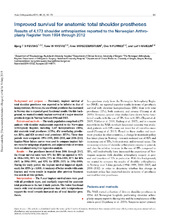| dc.description.abstract | Background and purpose — Previously, implant survival of total shoulder prostheses was reported to be inferior to that of hemiprostheses. However, the use of total prostheses has increased in Norway due to reported good functional results. On this background, we wanted to study implant survival of 4 major shoulder prosthesis types in Norway between 1994 and 2012. Patients and methods — The study population comprised 4,173 patients with shoulder replacements reported to the Norwegian Arthroplasty Register, including 2,447 hemiprostheses (HPs), 444 anatomic total prostheses (ATPs), 454 resurfacing prostheses (RPs), and 828 reversed total prostheses (RTPs). Three time periods were compared: 1994–1999, 2000–2005, and 2006–2012. Kaplan-Meier failure curves were used to compare implant failure rates for subgroups of patients, and adjusted risks of revision were calculated using Cox regression analysis. Results — For prostheses inserted from 2006 through 2012, the 5-year survival rates were 95% for HPs (as opposed to 94% in 1994–1999), 95% for ATPs (75% in 1994–1999), 87% for RPs (96% in 1994–1999), and 93% for RTPs (91% in 1994–1999). During the study period, the implant survival improved significantly for ATPs (p < 0.001). A tendency of better results with acute fracture and worse results in sequelae after previous fractures was seen in all time periods. Interpretation — The 5-year implant survival rates were good with all prosthesis types, and markedly improved for anatomic total prostheses in the last 2 study periods. The better functional results with total shoulder prostheses than with hemiprostheses support the trend towards increased use of total shoulder prostheses. | en_US |

